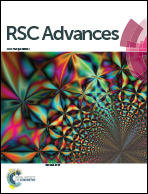Interfacial rheology and aggregation behaviour of amphiphilic CBABC-type pentablock copolymers at the air–water interface: effects of block ratio and chain length†
Abstract
The interfacial rheology and aggregation behaviour of three amphiphilic CBABC-type pentablock copolymers possessing different block ratios and chain lengths were investigated at the air–water interface, in which C, B and A represent poly(trifluoroethyl methacrylate)/PTFEMA, poly(methyl methacrylate)/PMMA and poly(ethylene glycol)/PEG, respectively. The influence of the block ratio and chain length on the interfacial rheology of the Langmuir films was studied via continuous compression, successive addition and step compression methods. The surface pressure–mean molecular area isotherms and limiting mean molecular areas of the three copolymers were studied via continuous compression. The surface pressure and modulus obtained from the continuous compression and successive addition methods were compared. Furthermore, the relaxation of the monolayer was discussed using the step compression method. A relaxation process was proposed that related to the adsorption–desorption exchange of molecules and polymer segments on the surface (fast relaxation process) and the reconformation of the adsorbed macromolecules inside the adsorption layer (slow relaxation process) at different mean molecular areas of compression. In addition, the Langmuir–Blodgett (LB) films prepared at various surface pressures from the three copolymers were scanned using atomic force microscopy (AFM) images, and a variety of morphologies such as macroporous, rugged, reticular and discontinuous continent structures were observed. Finally, the packing model of the structure evolution for the pentablock copolymer aggregates at the air–water interface was proposed.


 Please wait while we load your content...
Please wait while we load your content...